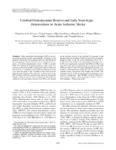Cerebral hemodynamic reserve and early neurologic deterioration in acute ischemic stroke

Not available until 9999-99-99
View/
Use this link to cite
http://hdl.handle.net/2183/40903Collections
- Investigación (FCS) [1293]
Metadata
Show full item recordTitle
Cerebral hemodynamic reserve and early neurologic deterioration in acute ischemic strokeAuthor(s)
Date
2004-11Citation
Alvarez FJ, Segura T, Castellanos M, Leira R, Blanco M, Castillo J, Dávalos A, Serena J. Cerebral hemodynamic reserve and early neurologic deterioration in acute ischemic stroke. J Cereb Blood Flow Metab. 2004 Nov;24(11):1267-71.
Abstract
[Abstract] Early neurological deterioration (END) is associated with increased mortality and morbidity. Although several predictive factors have been reported, there are little data about the hemodynamic factors. Our aim was to determine the capacity of cerebral hemodynamic reserve (CHR) to predict END. We studied 100 hospitalized patients with a first ever ischemic stroke of the middle cerebral artery (MCA) within the first 24 hours of symptoms onset. END was defined as a drop of at least one point in the Canadian Stroke Scale between admission and 72 hours. The mean flow velocity (mV) in the MCA and the CHR were measured by means of transcranial Doppler within the first 24 hours of admission. The CHR was expressed as the percentage increase in the MCA mV divided by the absolute increase in the end-tidal CO2 pressure in mm Hg after carbogen inhalation. END was observed in 23 patients. Reduced values of the mV in the symptomatic MCA (P = 0.043) and of the CHR in the symptomatic hemisphere (P < 0.001) were significantly associated with END. A CHR of less than 2%/1 mm Hg was independently associated with END (OR 8.45, 95% CI 1.82-39.2) after adjusting for potential confounders. CHR impairment within the first 24 hours of acute ischemic stroke is associated with a higher risk of END. This technique may be useful in selecting patients requiring a more intensive management.
Keywords
Hemodynamics
Stroke
Stroke
Editor version
ISSN
0271-678X





